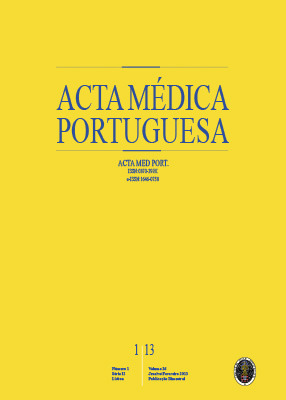Exercício e Dano das Vias Aéreas em Atletas
DOI:
https://doi.org/10.20344/amp.545Resumo
Os atletas olímpicos têm um risco aumentado de asma e alergia, principalmente aqueles que participam em desportos de resistência, tais como natação ou corrida, e em desportos de inverno. Os mecanismos clássicos subjacentes à asma induzida pelo exercício (AIE) incluem a hipótese osmótica, por desidratação das vias aéreas. Devido à hiperventilação, a evaporação da água da superfície das vias aéreas estimula o movimento da água a partir das células vizinhas, resultando em contração celular e libertação de mediadores inflamatórios que causam a contração do músculo liso. Mas o modelo explicativo de AIE/broncoconstrição em atletas provavelmente inclui a interação entre fatores ambientais, incluindo fatores relacionados com o treino, alérgenos e condições ambientais, tais como temperatura, humidade e qualidade do ar, bem como fatores de risco pessoais do atleta, como determinantes genéticos e neuroimuno- endócrinos. Os atletas, comparativamente a indivíduos menos ativos, têm maior taxa de infeções das vias aéreas superiores (IVAS) após o stress do treino e competições. O aumento da atividade física em indivíduos não-atletas associa-se a uma diminuição do risco de IVAS. O exercício intenso induz imunodepressão marcada, de origem multifatorial. A atividade física moderada pode melhorar a função imunológica, enquanto o exercício de alta intensidade, prolongado, prejudica temporariamente a capacidade imunológica. A relação entre exercício e IVAS é afetada fatores pouco conhecidos, incluindo determinantes individuais de suscetibilidade genética, inflamação neurogénica imunologicamente-mediada e disfunção da barreira epitelial. Os fatores etiológicos e mecanismos envolvidos na asma em atletas deverão ser alvo de estudos futuros no sentido de permitir propor medidas pertinentes de prevenção e terapêutica.
Downloads
Downloads
Como Citar
Edição
Secção
Licença
Todos os artigos publicados na AMP são de acesso aberto e cumprem os requisitos das agências de financiamento ou instituições académicas. Relativamente à utilização por terceiros a AMP rege-se pelos termos da licença Creative Commons ‘Atribuição – Uso Não-Comercial – (CC-BY-NC)’.
É da responsabilidade do autor obter permissão para reproduzir figuras, tabelas, etc., de outras publicações. Após a aceitação de um artigo, os autores serão convidados a preencher uma “Declaração de Responsabilidade Autoral e Partilha de Direitos de Autor “(http://www.actamedicaportuguesa.com/info/AMP-NormasPublicacao.pdf) e a “Declaração de Potenciais Conflitos de Interesse” (http://www.icmje.org/conflicts-of-interest) do ICMJE. Será enviado um e-mail ao autor correspondente, confirmando a receção do manuscrito.
Após a publicação, os autores ficam autorizados a disponibilizar os seus artigos em repositórios das suas instituições de origem, desde que mencionem sempre onde foram publicados e de acordo com a licença Creative Commons









